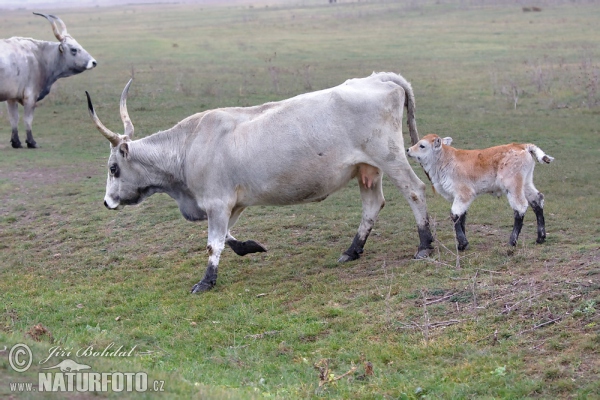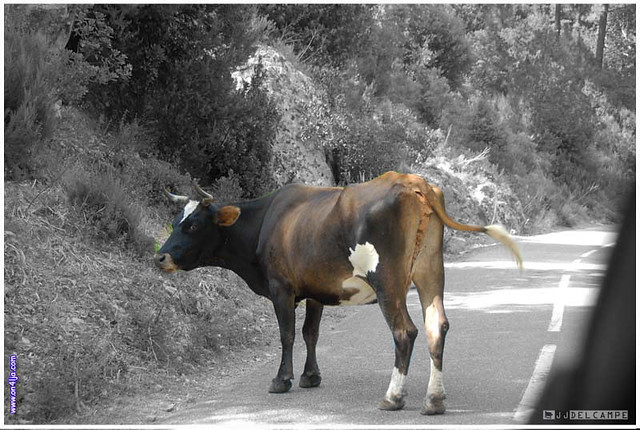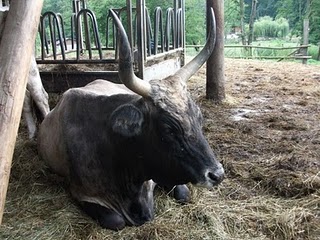To know
what we are dealing with, it’s important to have a look at the breeds that were
used to create modern Heck cattle. This post discusses which breeds
might have the largest influence on modern-day Heck cattle, and not to
be a critical review of the Heck brother’s experiment. For this, you can have a
look at Cis van Vuure’s book Retracingthe Aurochs – History, Morphology and Ecology of an extinct wild Ox, 2005.
One problem
is that the Hecks did not keep track of their breeding after the early 30s, so
that the pedigree of particular Heck cattle individuals was actually unknown
until an international breeding book as created in 1980. Therefore, we have to
guess which breed left the strongest mark in Heck cattle by looking at the
history of the breed and the phenotype displayed by contemporary individuals.
As the
Berlin lineage bred by Lutz Heck died out during WWII and probably did not
contribute
to the remaining Heck cattle, the breeds used by Heinz Heck are in the focus of
our interest, which are:
Angeln cattle* No wild colour, dairy breed, small horns of
variable curvature
Black-pied lowland cattle (old lineage of the
Frisian) no wild
colour, dairy breed, small horns of variable curvature
Braunvieh grayish-brown wild colour with strongly reduced
sexual dimorphism, dairy breed but comparably slender, small horns of variable
curvature
Murnau-Werdenfelser wild colour with reduced sexual dimorphism,
dairy breed, small horns of variable curvature
Hungarian/Podolian Steppe cattle** whitish wild colour with greatly
reduced dimorphism, usually slender body, large but upright horns
Highland cattle no wild colour, small and stubby body, long
horns of variable curvature
Corsican cattle wild colour, body slender but not athletic,
small horns of vaguely aurochs-like curvature
* as an
interesting side note, the Angeln cattle were smaller and slenderer back these
days: http://www.anglerrind-az.de/img/geschichte-head.jpg
** These are
almost identical breeds, therefore I will refer to them only as Steppe cattle
For
whatever reason, Heinz Heck relied more on central-European dairy breeds with
little resemblance to the aurochs than his brother did, who used southern
breeds to a large extent. The “first Heck cattle” was a bull born in 1932,
which was an F4 individual that consisted of 75% Corsican cattle and 25% a mix
of Steppe cattle, Angeln cattle, Highland and Lowland cattle. After that bull
was born, Heinz Heck added Braunvieh and Murnau-Werdenfelser. If he also
included English Park cattle and crosses from his brother is dubious, because the
documents of the Hecks are unclear about this. Interestingly, H. Heck remarks
he learned that using Steppe cattle, Highland cattle, Fighting cattle and Texas
longhorn is the fastest combination to gain an aurochs look-alike (although
neither he nor his brother used Texas longhorn, by the way).
Although
the Hecks themselves did not continue their experiment after WWII, some further
crosses took place in other zoos. For example, Hungarian steppe cattle were
crossed-in in some herds again. Also a Watussi cow was crossed-in in a German zoo in 1952,
resulting in a crossbred cow that left its trace in the Neandertal lineage and
their descendants.
That’s how
far the history of the breed goes. Now let’s look at the phenotype of modern
Heck cattle in order to see the influence of the respective breeds.
Black-pied
lowland cattle and Angeln cattle have little diagnostic features in this
selection of breeds, probably you’d only recognize their influence by their
colour genes. Angeln cattle lack, as far as I know, the wild type allele (E+) but carry the e mutation instead, resulting in a red
coat without any dark pigmentation. This colour pops out in some Heck cattle,
but is not very common. Black-pied lowland cattle carry the ED mutation instead,
resulting in a uniformly black coat in both sexes and also calves. I am not
sure if this occurs in modern Heck cattle. But black-pied cattle also carry
alleles for white spotting on the S
locus. Unfortunately, Heck cattle with white spots keep showing up in various
lineages, therefore the influence of the one black-pied bull is still there. Most
Heck cattle have the wild colour gene E+,
and display a large degree of variation concerning the expression of this
feature. Within this diverse pool, the colours of all the wild type coloured
founding breeds show up (Steppe cattle, Murnau-Werdenfelser, Braunvieh,
Corsican). Grayish, beige or whitish individuals are common “throwbacks”,
indicating a strong presence of Steppe cattle. Although the colours of Highland
cattle is rarely seen among Heck cattle (which in fact include the same colour
genes as in Angeln and black-pied cattle, or the Simmental dilution gene that results in a lighter coat), other
features, such as the body shape (if you imagine it without the long coat) or
horn shape of many Heck cattle, can resemble Highlands to a large extent. Some
even show a longish coat all the year around. The horn shapes and dimensions among
Heck cattle are extremely variable, but the lyre-shaped horns, present both in
Highland and Steppe cattle, are common among Heck cows, and the long, straight
and upright horns of Steppe cattle bulls are common among bulls as well. Heck
cattle display nearly all types of body shapes and proportions among their
founding breeds, but many resemble Steppe cattle, Corsican cattle,
Murnau-Werdenfelser and Braunvieh. Looking at the overall appearance, some Heck
cattle really look like nearly-aurochs-coloured Steppe cattle or Corsican
cattle with larger horns. There are not many photos of Corsican cattle in the
web (and many of them are influenced by other breeds already), but those that I
have seen show a clear resemblance with Heck cattle. The Corsican seems to show
almost every colour variation present in Heck cattle (except very lightly
coloured ones), and the horn curvature also is very alike. Some Corsican cows
are virtually indistinguishable from some Heck cows, except that the latter
tends to have longer horns. The Heck cattle’s history also implicates that both
Corsican and Steppe cattle left a strong mark in the breed, because the former
was used by H. Heck to a large extent and Steppe cattle played an important
role in the experiment as well and was crossed in subsequently again. Also
Watussi might not have been unimportant, although only one crossbred cow was
used. Its influence probably enabled the breed to gain large and well-curved
horns that are seen among several German Heck lineages today, although it is
likely that not all Heck cattle have that half-Watussi in their ancestry. ThisHeck bull from Germany also resembles Watussi in having a slightly
downwards-facing pelvis, giving it a more rounded rear, and also the horns of
this individual remind me of Watussi.
All in all,
I came to the conclusion that the most important founding breeds of Heck cattle
probably are Corsican cattle and Steppe cattle, followed by Highland cattle and
Murnau-Werdenfelser/Braunvieh. A cross of 75% Corsican and 25% Steppe cattle
probably results in an animal that is very alike some Heck cattle. And single
individuals or even herds of that breed, on the other hand, resemble these four
breeds to such an extent that it probably would be possible to breed an effigy
of these out of the modern Heck population. But, due to inconsequent selection,
features of virtually all founding breeds are still recognizable in single within
the total of the modern Heck cattle population.
What
follows now is a selection of individuals of the founding breeds that show a
decent similarity with Heck cattle (I own none of these photos):
 |
| Corsican cattle greatly resembling Heck cattle (nevermind the white spots, these are the result of crossbreeding) |
 |
| Steppe cattle resembling some Heck cattle |
 |
| Murnau-Werdenfelser resembling Hecks |
 |
| Braunvieh cow resembling some Hecks |
Literature
- van Vuure, Cis: Retracing the Aurochs - History, Morphology and Ecology of an extinct wild Ox.
- Frisch, Walter: Der Auerochs – das europäische Rind. 2010.
- http://www.piedmontese.org/Coat%20Color%20Cattle.pdf









No comments:
Post a Comment